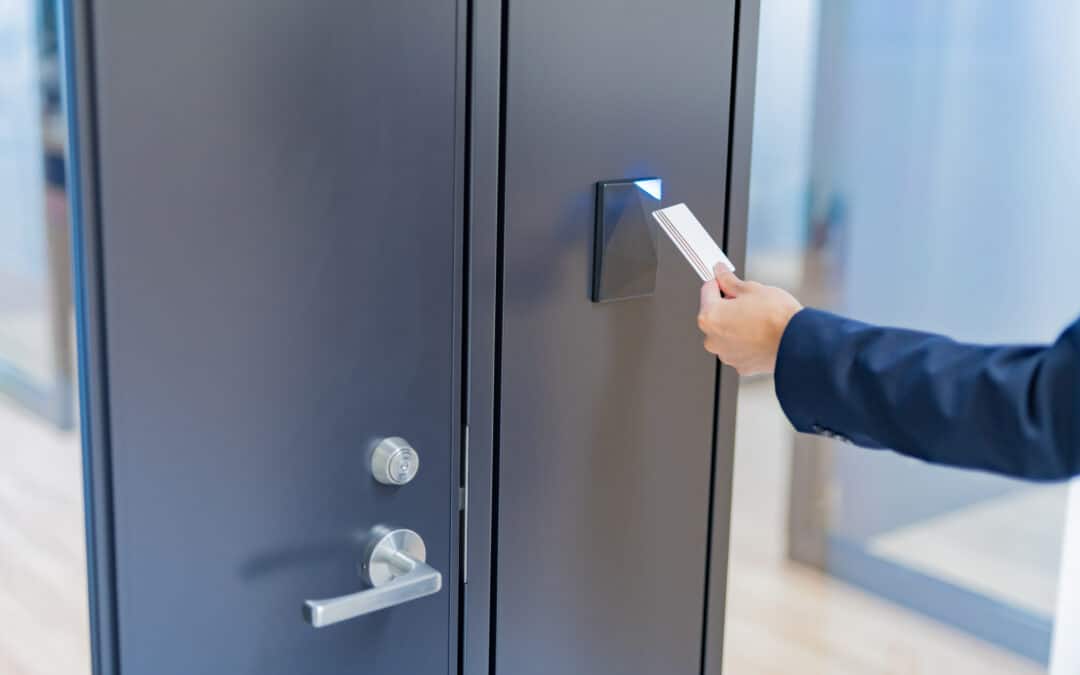Access Control Systems Explained: Key Cards, Biometrics, and Beyond
In today’s world, safeguarding your assets, employees, students, and sensitive information is paramount for any organization, from a corporate office to a school campus. Traditional lock-and-key systems often fall short, offering limited control and poor visibility. This is where access control systems step in, providing a scalable solution for managing who goes where and when.
Robust physical security solutions are a key part of keeping your organization secure and running properly. An effective access control system not only restricts unauthorized entry but also offers data for security audits and emergency management.
What is an Access Control System?
An access control system is a security measure designed to regulate who is allowed to enter specific areas of a building or property. Instead of a physical key, these systems use credentials to grant or deny entry, making security management more efficient and secure. This core function is vital for any organization looking to enhance its commercial or educational campus security systems.
Types of Access Credentials
The journey of access control has seen remarkable technological advancements. What began with simple methods has evolved into a variety of highly secure and convenient options.
1. Physical Credentials (Key Cards & Fobs)
Key cards and fobs remain a popular choice due to their reliability and ease of use.
- Proximity Cards & Fobs: These use RFID (Radio-Frequency Identification) technology. A simple wave of the card or fob near a reader grants access, making entry quick and contactless. They are widely used for office buildings, general staff access, and school entrances.
- Smart Cards: Smart cards can store more data and often require a PIN in addition to the card, adding a second layer of authentication. They are ideal for areas requiring higher security, such as data centers or research labs.
2. Biometric Access Control
Biometric security systems offer the highest level of personal identification by using unique biological characteristics. These systems virtually eliminate the risk of lost or stolen credentials and provide irrefutable proof of identity.
- Fingerprint Scanners: The most common biometric method, offering quick and accurate verification.
- Facial Recognition: Utilizes unique facial features for identification, often used in high-security zones or for hands-free access.
- Iris/Retinal Scanners: Analyzes the unique patterns in a person’s eye. These are typically deployed in environments with the strictest security requirements.
3. Mobile Access Control
Mobile access control allows employees to use their own devices as credentials. A secure app connects with readers using Bluetooth or NFC (Near Field Communication). This offers convenience and reduces the need for physical cards.
Modern Advancements in Access Control
Cloud-Based Access Control
Cloud-based access control allows you to manage your entire security system from anywhere with an internet connection. Instead of housing servers on-site, the system is managed through a secure online portal. This provides incredible flexibility, allowing administrators to grant or revoke access, monitor activity, and respond to real-time alerts from a phone or computer. It also simplifies scalability, making it easy to add new doors, users, or locations without major hardware changes.
The Role of AI in Access Control
Artificial Intelligence (AI) is making access control systems smarter and more proactive. AI algorithms can analyze access patterns over time to identify unusual behavior, such as someone trying to access a sensitive area outside of normal hours, and flag it as a potential threat.
In biometric systems, AI enhances the accuracy of facial and fingerprint recognition, reducing false rejections and improving user experience. This intelligence turns a reactive security measure into a predictive one.
Multi-Factor Authentication (MFA) for Layered Security
Multi-Factor Authentication (MFA) requires a user to present two or more different types of credentials to gain access. This creates a layered defense that is significantly more difficult to breach. Common MFA combinations include:
- Combining a physical credential, like a key card or mobile phone, with a code, such as a PIN or password.
- Pairing a physical item, like a key fob, with a biometric scan from the user, such as their fingerprint.
By requiring multiple verification methods, MFA ensures that even if one credential is compromised, the protected area remains secure.
Benefits of Implementing an Access Control System
Beyond simply opening doors, integrating an advanced access control system brings many benefits:
- Enhanced Security: Restrict entry to authorized personnel only, protecting sensitive areas, valuable assets, students, and staff.
- Increased Accountability: Track and log every entry and exit, providing a clear audit trail for compliance.
- Flexibility and Control: Easily grant or revoke access rights for individuals or groups in real-time. Ideal for managing new hires, departing employees, or temporary visitors.
- Reduced Risk of Key Duplication: Eliminate the vulnerability associated with physical keys being lost, stolen, or illegally copied.
- Integration Capabilities: Seamlessly integrate with other security systems, such as video surveillance, alarm systems, and time and attendance software, creating a comprehensive security system. This is a key component of unified security platforms.
- Emergency Management: Facilitate quicker and safer evacuations by easily unlocking all doors in an emergency or quickly securing a campus during a lockdown.
Choosing the Right System for Your Organization
Selecting the right access control solution depends on your specific security needs, operational scale, and budget. Considerations include the level of security required for different areas, the number of users and locations, integration with existing network infrastructure, and scalability for future growth.
ICAS specializes in installing access control systems that align with your organizational objectives. From initial consultation to ongoing support, we ensure your premises are secured with the most reliable technology available.
Secure Your Future Today
Investing in an access control system is an investment in your organization’s future security and efficiency. Whether you’re considering a transition from traditional locks, upgrading an outdated system, or implementing a new security infrastructure, ICAS is your trusted partner.
Contact us to discuss how we can customize an access control solution that meets the unique demands of your organization.

